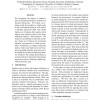Free Online Productivity Tools
i2Speak
i2Symbol
i2OCR
iTex2Img
iWeb2Print
iWeb2Shot
i2Type
iPdf2Split
iPdf2Merge
i2Bopomofo
i2Arabic
i2Style
i2Image
i2PDF
iLatex2Rtf
Sci2ools
ACL
2015
2015
The Impact of Listener Gaze on Predicting Reference Resolution
We investigate the impact of listener’s gaze on predicting reference resolution in situated interactions. We extend an existing model that predicts to which entity in the environment listeners will resolve a referring expression (RE). Our model makes use of features that capture which objects were looked at and for how long, reflecting listeners’ visual behavior. We improve a probabilistic model that considers a basic set of features for monitoring listeners’ movements in a virtual environment. Particularly, in complex referential scenes, where more objects next to the target are possible referents, gaze turns out to be beneficial and helps deciphering listeners’ intention. We evaluate performance at several prediction times before the listener performs an action, obtaining a highly significant accuracy gain.
| Added | 13 Apr 2016 |
| Updated | 13 Apr 2016 |
| Type | Journal |
| Year | 2015 |
| Where | ACL |
| Authors | Nikolina Koleva, Martin Villalba, Maria Staudte, Alexander Koller |
Comments (0)

